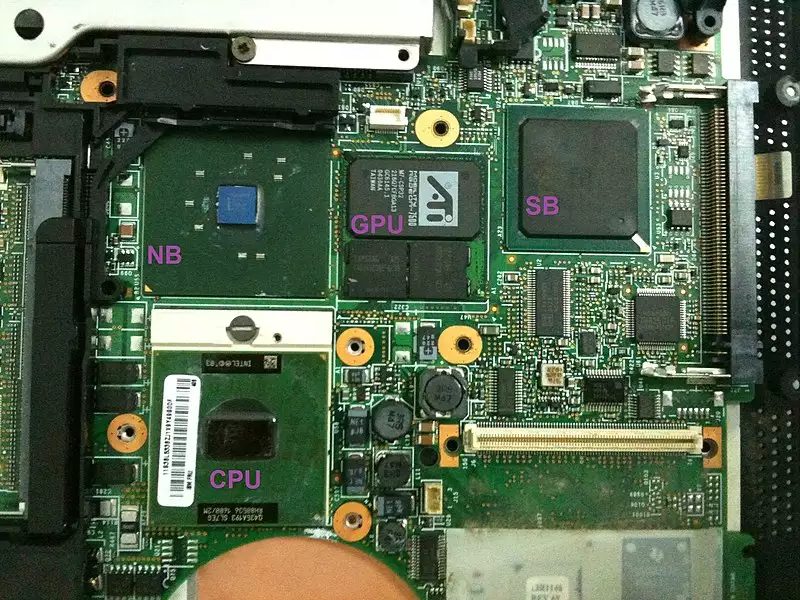Chipset
In a computer system, a chipset is a set of electronic components in an integrated circuit known as a "Data Flow Management System" that manages the data flow between the processor, memory and peripherals. It is usually found on the motherboard. Chipsets are usually designed to work with a specific family of microprocessors. Because it controls communications between the processor and external devices, the chipset plays a crucial role in determining system performance.
In computing, the term chipset commonly refers to a set of specialized chips on a computer's motherboard or an expansion card. In personal computers, the first chipset for the IBM PC AT of 1984 was the NEAT chipset developed by Chips and Technologies for the Intel 80286 CPU.
The term chipset often refers to a specific pair of chips on the motherboard: the northbridge and the southbridge. The northbridge links the CPU to very high-speed devices, especially RAM and graphics controllers, and the southbridge connects to lower-speed peripheral buses (such as PCI or ISA). In many modern chipsets, the southbridge contains some on-chip integrated peripherals, such as Ethernet, USB, and audio devices.
Motherboards and their chipsets often come from different manufacturers. As of 2015, manufacturers of chipsets for x86 motherboards include AMD, Intel and VIA Technologies.
In the 1980s, Chips and Technologies pioneered the manufacturing of chipsets for PC-compatible computers. Computer systems produced since then often share commonly used chipsets, even across widely disparate computing specialties. For example, the NCR 53C9x, a low-cost chipset implementing a SCSI interface to storage devices, could be found in Unix machines such as the MIPS Magnum, embedded devices, and personal computers.
Traditionally in x86 computers, the processor's primary connection to the rest of the machine was through the motherboard chipset's northbridge. The northbridge was directly responsible for communications with high-speed devices (system memory and primary expansion buses, such as PCIe, AGP, and PCI cards, being common examples) and conversely any system communication back to the processor. This connection between the processor and northbridge is commonly designated the front side bus (FSB). Requests to resources not directly controlled by the northbridge were offloaded to the southbridge, with the northbridge being an intermediary between the processor and the southbridge. The southbridge handled "everything else", generally lower-speed peripherals and board functions (the largest being hard disk and storage connectivity) such as USB, parallel and serial communications. In 1990s and early 2000s, the interface between a northbridge and southbridge was the PCI bus.
Before 2003, any interaction between a CPU and main memory or an expansion device such as a graphics card(s) — whether AGP, PCI or integrated into the motherboard — was directly controlled by the northbridge IC on behalf of the processor. This made processor performance highly dependent on the system chipset, especially the northbridge's memory performance and ability to shuttle this information back to the processor. In 2003, however, AMD's introduction of the Athlon 64-bit series of processors changed this. The Athlon64 marked the introduction of an integrated memory controller being incorporated into the processor itself thus allowing the processor to directly access and handle memory, negating the need for a traditional northbridge to do so. Intel followed suit in 2008 with the release of its Core i series CPUs and the X58 platform.
In newer processors integration has further increased, primarily through the inclusion of the system's primary PCIe controller and integrated graphics directly on the CPU itself. As fewer functions are left un-handled by the processor, chipset vendors have condensed the remaining northbridge and southbridge functions into a single chip. Intel's version of this is the "Platform Controller Hub" (PCH) while AMD's version was called Fusion Controller Hub (FCH, this name stopped being used with the release of the Zen architecture), effectively an enhanced southbridge for the remaining peripherals—as traditional northbridge duties, such as memory controller, expansion bus (PCIe) interface and even on-board video controller, are integrated into the CPU die itself (the chipset often contains secondary PCIe connections though). However, the Platform Controller Hub was also integrated into the processor package as a second die for mobile variants of the Skylake processors. The northbridge to southbridge interconnect interfaces used now are DMI (Intel) and UMI (AMD).
六级/考研单词: compute, electron, component, integrate, data, neat, seldom, audio, manufacture, pioneer, implement, embed, converse, designate, parallel, serial, interact, behalf, shuttle, thereby, negate, farther, vendor, condense, fusion, parcel, mobile

A part of an IBM T42 laptop motherboard. CPU: Central processing unit. NB: Northbridge. GPU: Graphics processing unit. SB: Southbridge.
Detailed specifications - ThinkPad T42, T42p - Lenovo Support US 2373-F7G - ThinkWiki
Currently (~2020), most VIA chipsets are consider legacy/mature or obsolete. VIA chipsets were alternatives to Intel's own chipsets; or supported AMD cpus (e.g., Athlon-K8) and even VIA's own processors (e.g., C3 / C7). They supported CPUs as early as the i386 in the early-1990s. In the early-2000s, the chipsets offered on-chip graphics support from VIA's joint venture with S3 Graphics beginning in 2001 and continued to be active into the early 2010s, with release of the VX11H in Aug-2012. Use of VIA chipsets diminished beginning the mid-2010s as alternatives offered better performance, VIA entered other markets and Intel began offering better performing integrated-graphics in their own chipsets and cpu-dies. (See Intel GMA and Intel Graphics Technology.)
Nvidia Ion was a product line of Nvidia Corporation intended for motherboards of low-cost portable computers. It used graphics processing units and chipsets intended for small products. NVIDIA's Ion comes in as an alternative two-chip solution. The GeForce 9400M is a single chip, the other chip is the Atom, and the two make up Ion. You get a modern memory controller as well, supporting both DDR2 and DDR3 memory (up to DDR3-1066).




 浙公网安备 33010602011771号
浙公网安备 33010602011771号